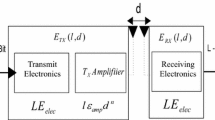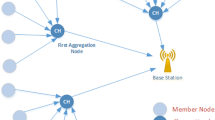Abstract
To improve the network lifetime of battery-operated wireless sensor networks (WSNs), effective deployment of available low-power resources is required. This is essential as it is impractical to exchange or recharge the energy resource after deployment. To properly utilize the limited energy, a suitable cluster-based data aggregation technique is required, which considerably reduces the network’s overall energy usage. Therefore, this work proposes a cluster-based data aggregation technique called Scalable Clustering Algorithm for Data Aggregation (SCADA). Each cluster has a single cluster head (CH) and several cluster relays (CRs) in this algorithm. The number of CRs in a cluster varies depending on the cluster’s geographic position in relation to the Base Station. We assure that energy usage is reduced as a result of the multi-hop short-distance data transmission by doing so. In hybrid modes, the CHs are also rotated at the appropriate intervals to reduce control packets. The proposed algorithm is novel and well suited for both homogeneous and heterogeneous WSNs because it uses a hybrid CH selection mechanism, a threshold-based CH rotation mechanism, and a mechanism of allocating dedicated CR in each cluster. Effects of variations in the length of the sensing field, variation in SN density, variation in Cluster count, and variation in initial energy and heterogeneity test are used to assess the proposed algorithm’s efficiency. SCADA is incredibly scalable for large-scale WSN and energy-efficient with a small number of control messages as depicted by the analytical results. Simulation-based results, clearly states that as compared to three protocols EESCT, DUCF, and MUCA, SCADA obtains approximately 35%, 25%, and 10%, respectively, more rounds of communication. SCADA drastically improves when the length of the sensing field increases as compared to EESCT, DUCF, and MUCA. SCADA when compared to the EESCT, DUCF, and MUCA algorithms, the average energy consumption is significantly lower by 21 to 38%.







Similar content being viewed by others
Abbreviations
- ACR:
-
Average communication range
- BS:
-
Base station
- CH:
-
Cluster head
- CHNSN:
-
Cluster head to normal sensor node ratio
- CMNs:
-
Cluster member nodes
- CR:
-
Cluster relays
- CRC:
-
Cycle error detection code
- DUCF:
-
Distributed unequal clustering with fuzzy logic
- EESCA-WR:
-
Energy-efficient clustering algorithm with relay
- EESCT:
-
Energy-efficient cluster-based scheduling technique
- Fs:
-
Free space
- FT-CHSDA:
-
Fault tolerant CH selection and data aggregation scheme
- GPS:
-
Global positioning system
- HWSN:
-
Hierarchical wireless sensor network
- MEACBM:
-
Mobile energy aware cluster based multi-hop
- Mp:
-
Multi path
- MUCA:
-
Multiple layers uneven clustering Algorithm
- ORCHS:
-
Optimal RSSI CH selection
- RSCT:
-
Resilient steady clustering technique
- RSSI:
-
Radio signal strength index
- SBN:
-
Standby node
- SCADA:
-
Scalable cluster-based data aggregation
- SNs:
-
Sensor nodes
- TDMA:
-
Time-division multiple access
- UID:
-
Unique identifier
- WSNs:
-
Wireless sensor networks
References
Pan J, Cai L, Hou YT, Shi Y, Shen SX (2005) Optimal base-station locations in two-tiered wireless sensor networks. IEEE Trans Mob Comput 4(5):458–473
Jain K, Kumar A (2020) Energy-efficient data-aggregation technique for correlated spatial and temporal data in cluster-based sensor networks. Int J Bus Data Commun Netw (IJBDCN) 16(2):53–68
Singh A, Jain K (2022) An automated lightweight key establishment method for secure communication in WSN. Wirel Pers Commun. https://doi.org/10.1007/s11277-022-09492-6
Agarwal A, Dev A, Jain K (2020) Prolonging sensor network lifetime by using energy-efficient cluster-based scheduling. Int J Sci Technol Res, 9(04)
Dhand G, Tyagi SS (2016) Data aggregation techniques in WSN: survey. Proc Comput Sci 92:378–384
Rault T, Bouabdallah A, Challal Y (2014) Energy efficiency in wireless sensor networks: a top-down survey. Comput Netw 67:104–122
Tokognon CA, Gao B, Tian GY, Yan Y (2017) Structural health monitoring framework based on Internet of Things: a survey. IEEE Internet Things J 4(3):619–635
Salam A (2020) Internet of things for water sustainability. In: Salam A (ed) Internet of Things for sustainable community development. Springer, Cham, pp 113–145
Aziz ZAA, Ameen SYA (2021) Air pollution monitoring using wireless sensor networks. J Inf Technol Inform 1(1):20–25
Goyal N, Dave M, Verma AK (2019) Data aggregation in underwater wireless sensor network: recent approaches and issues. J King Saud Univ Comput Inform Sci 31(3):275–286
Jain K, Kumar A (2020) An energy-efficient prediction model for data aggregation in sensor network. J Ambient Intell Humaniz Comput 11(11):5205–5216
Gupta K, Sikka V (2015) Design issues and challenges in wireless sensor networks. Int J Comput Appl 112(4):0975–8887
Gubbi J, Buyya R, Marusic S, Palaniswami M (2013) Internet of Things (IoT): A vision, architectural elements, and future directions. Futur Gener Comput Syst 29(7):1645–1660
Jain K, Agarwal A, Kumar A (2021) A novel data prediction technique based on correlation for data reduction in sensor networks. In: Proceedings of international conference on artificial intelligence and applications (pp 595–606). Springer, Singapore
Agarwal A, Gupta K, Yadav KP (2016) A novel energy efficiency protocol for WSN based on optimal chain routing. In: 2016 3rd International Conference on Computing for Sustainable Global Development (INDIACom) (pp 368–373). IEEE
Comito C, Talia D, Trunfio P (2011) An energy-aware clustering scheme for mobile applications. In: 2011 IEEE 11th International Conference on Computer and Information Technology (pp 15–22). IEEE
Dziengel N, Seiffert M, Ziegert M, Adler S, Pfeiffer S, Schiller J (2016) Deployment and evaluation of a fully applicable distributed event detection system in Wireless Sensor Networks. Ad Hoc Netw 37:160–182
Rostami AS, Badkoobe M, Mohanna F, Hosseinabadi AAR, Sangaiah AK (2018) Survey on clustering in heterogeneous and homogeneous wireless sensor networks. J Supercomput 74(1):277–323
Jain K, Bhola A (2018) Data aggregation design goals for monitoring data in wireless sensor networks. J Netw Secur Comput Netw 4(3):1–9
Chan L, Chavez KG, Rudolph H, Hourani A (2020) Hierarchical routing protocols for wireless sensor network: a compressive survey. Wireless Netw 26(5):3291–3314
Maratha P, Gupta K (2019) A comprehensive and systematized review of energy-efficient routing protocols in wireless sensor networks. Int J Comput Appl, 1–18
Comito C, Talia D (2017) Energy consumption of data mining algorithms on mobile phones: evaluation and prediction. Pervasive Mob Comput 42:248–264
Baranidharan B, Santhi B (2016) DUCF: distributed load balancing unequal clustering in wireless sensor networks using fuzzy approach. Appl Soft Comput 40:495–506
Liu J, Su S, Lu Y, Dong J (2018) Multiple layers uneven clustering algorithm based on residual energy for wireless sensor networks. J Eng 2018(16):1555–1560
Toor AS, Jain AK (2019) Energy aware cluster based multi-hop energy efficient routing protocol using multiple mobile nodes (MEACBM) in wireless sensor networks. AEU-Int J Electron Commun 102:41–53
Jain K, Kumar A (2019) An optimal RSSI-based cluster-head selection for sensor networks. Int J Adapt Innov Syst 2(4):349–361
Padmanaban Y, Muthukumarasamy M (2020) Scalable grid-based data gathering algorithm for environmental monitoring wireless sensor networks. IEEE Access 8:79357–79367
Jain K, Kumar A, Jha CK (2019) Probabilistic-based energy-efficient single-hop clustering technique for sensor networks. Commun Intell Syst. ICCIS
Jain K, Kumar A, Vyas V (2020) A resilient steady clustering technique for sensor networks. Int J Appl Evolut Comput (IJAEC) 11(4):1–12
Chanak P, Banerjee I, Sherratt RS (2020) A green cluster-based routing scheme for large-scale wireless sensor networks. Int J Commun Syst 33(9):e4375
Jain K, Singh A (2021) An empirical cluster head selection and data aggregation scheme for a fault-tolerant sensor network. Int J Distrib Syst Technol (IJDST) 12(3):27–47. https://doi.org/10.4018/IJDST.2021070102
Hasheminejad E, Barati H (2021) A reliable tree-based data aggregation method in wireless sensor networks. Peer-to-Peer Netw Appl 14(2):873–887
Goyal N, Dave M, Verma AK (2020) SAPDA: secure authentication with protected data aggregation scheme for improving QoS in scalable and survivable UWSNs. Wireless Pers Commun 113(1):1–15
Agarwal A, Jain K, Dev A (2022) BFL: a buffer based linear filtration method for data aggregation in wireless sensor networks. Int J Inf Technol. https://doi.org/10.1007/s41870-022-00879-z
Pakdel H, Fotohi R (2021) A firefly algorithm for power management in wireless sensor networks (WSNs). J Supercomput 77(9):9411–9432
Heinzelman WR, Chandrakasan A, Balakrishnan H (2000) Energy-efficient communication protocol for wireless mi-crosensor networks. In: Proceedings of the 33rd annual Hawaii inter-national conference on system sciences (pp 10-pp). IEEE
Heinzelman WB, Chandrakasan AP, Balakrishnan H (2002) An application-specific protocol architecture for wireless microsensor networks. IEEE Trans Wireless Commun 1(4):660–670
Jain K, Kumar A (in press) An innovative framework for balanced cluster-based data aggregation in Sensor Networks. Int J Commun Syst
Issariyakul T, Hossain E (2009) Introduction to network simulator 2 (NS2). In: Issariyakul T, Hossain E (eds) Introduction to network simulator NS2. Springer, Boston, MA, pp 1–18
Chernyshev M, Baig Z, Bello O, Zeadally S (2017) Internet of things (iot): Research, simulators, and testbeds. IEEE Internet Things J 5(3):1637–1647
Kumar D, Aseri TC, Patel R (2009) EEHC: Energy efficient heterogeneous clustered scheme for wireless sensor networks. Comput Commun 32(4):662–667
Author information
Authors and Affiliations
Corresponding author
Ethics declarations
Conflict of interest
The authors declare that they have no conflict of interest.
Ethical approval
This article does not contain any studies with human participants or animals per-formed by any of the authors.
Additional information
Publisher's Note
Springer Nature remains neutral with regard to jurisdictional claims in published maps and institutional affiliations.
Rights and permissions
About this article
Cite this article
Jain, K., Mehra, P.S., Dwivedi, A.K. et al. SCADA: scalable cluster-based data aggregation technique for improving network lifetime of wireless sensor networks. J Supercomput 78, 13624–13652 (2022). https://doi.org/10.1007/s11227-022-04419-1
Accepted:
Published:
Issue Date:
DOI: https://doi.org/10.1007/s11227-022-04419-1




